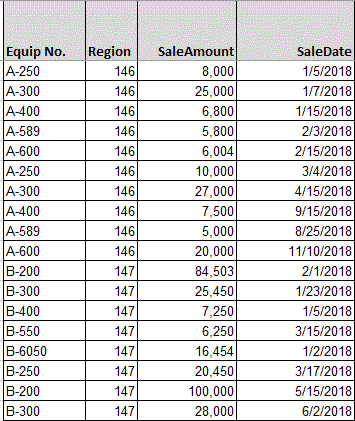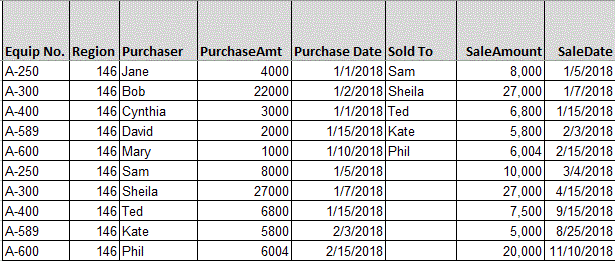Have a voluminous monthly MS Excel worksheet (Over 240,000 records) with equipment sale and re-sale data throughout the
year such as displayed below.
EqNo------- Region------ SaleAmount-------SaleDate
A-250------- 146------- 8,000------- 1/5/2018
A-300------- 146------- 25,000------- 1/7/2018
A-400------- 146------- 6,800------- 1/15/2018
A-589------- 146------- 5,800------- 2/3/2018
A-600------- 146------- 6,004------- 2/15/2018
A-250------- 146------- 10,000------- 3/4/2018
A-300------- 146------- 27,000------- 4/15/2018
A-400------- 146------- 7,500------- 9/15/2018
A-589------- 146------- 5,000------- 8/25/2018
A-600------- 146------- 20,000------- 11/10/2018
B-200------- 147------- 84,503------- 2/1/2018
B-300------- 147------- 25,450------- 1/23/2018
B-400------- 147------- 7,250------- 1/5/2018
B-550------- 147------- 6,250------- 3/15/2018
B-655------- 147------- 16,454------- 1/2/2018
B-250------- 147------- 20,450------- 3/17/2018
B-200------- 147------- 100,000------- 5/15/2018
B-300------- 147------- 28,000------- 6/2/2018
B-400------- 147------- 8,250------- 10/23/2018
B-550------- 147------- 5,000------- 6/8/2018
B-655------- 147------- 30,000------- 6/26/2018
B-250------- 147------- 35,000------- 8/25/2018
Objective is to populate the MS Excel worksheet as displayed in the second image below.
In other words, I need to determine the variance between the Equipment sale prices over time and create "buckets" to display the number of equipment, the average sales price and average re-sale prices for the equipment by month by "buckets."
Note, each piece of equipment can be sold and re-sold multiple times during the year.
The time buckets are as follows;
# 0 - 6 Month Resale
0-6 Months Avg purchase price
0-6 Month avg resale price
# 6-12 Months Resales
6-12 Months Avg purchase price
6-12 Month avg resale price
# 0 -12 Month Resales
0-12 Months Avg purchase price
0-12 Month avg resale price
So far, I have contemplated adding a "helper" column to calculate the difference between the equipment sale dates for each unique equipment and then use a pivot table to group the data by month.
Then considered the use of sumproduct.
Still reviewing/experimenting with various options... objective.
I have attached an MS Excel spreadsheet for reference.
Appreciate any insight as to an efficient method to accomplish the objective.


year such as displayed below.
EqNo------- Region------ SaleAmount-------SaleDate
A-250------- 146------- 8,000------- 1/5/2018
A-300------- 146------- 25,000------- 1/7/2018
A-400------- 146------- 6,800------- 1/15/2018
A-589------- 146------- 5,800------- 2/3/2018
A-600------- 146------- 6,004------- 2/15/2018
A-250------- 146------- 10,000------- 3/4/2018
A-300------- 146------- 27,000------- 4/15/2018
A-400------- 146------- 7,500------- 9/15/2018
A-589------- 146------- 5,000------- 8/25/2018
A-600------- 146------- 20,000------- 11/10/2018
B-200------- 147------- 84,503------- 2/1/2018
B-300------- 147------- 25,450------- 1/23/2018
B-400------- 147------- 7,250------- 1/5/2018
B-550------- 147------- 6,250------- 3/15/2018
B-655------- 147------- 16,454------- 1/2/2018
B-250------- 147------- 20,450------- 3/17/2018
B-200------- 147------- 100,000------- 5/15/2018
B-300------- 147------- 28,000------- 6/2/2018
B-400------- 147------- 8,250------- 10/23/2018
B-550------- 147------- 5,000------- 6/8/2018
B-655------- 147------- 30,000------- 6/26/2018
B-250------- 147------- 35,000------- 8/25/2018
Objective is to populate the MS Excel worksheet as displayed in the second image below.
In other words, I need to determine the variance between the Equipment sale prices over time and create "buckets" to display the number of equipment, the average sales price and average re-sale prices for the equipment by month by "buckets."
Note, each piece of equipment can be sold and re-sold multiple times during the year.
The time buckets are as follows;
# 0 - 6 Month Resale
0-6 Months Avg purchase price
0-6 Month avg resale price
# 6-12 Months Resales
6-12 Months Avg purchase price
6-12 Month avg resale price
# 0 -12 Month Resales
0-12 Months Avg purchase price
0-12 Month avg resale price
So far, I have contemplated adding a "helper" column to calculate the difference between the equipment sale dates for each unique equipment and then use a pivot table to group the data by month.
Then considered the use of sumproduct.
Still reviewing/experimenting with various options... objective.
I have attached an MS Excel spreadsheet for reference.
Appreciate any insight as to an efficient method to accomplish the objective.



![[glasses] [glasses] [glasses]](/data/assets/smilies/glasses.gif) Just traded in my OLD subtlety...
Just traded in my OLD subtlety...![[tongue] [tongue] [tongue]](/data/assets/smilies/tongue.gif)

![[ponder] [ponder] [ponder]](/data/assets/smilies/ponder.gif)